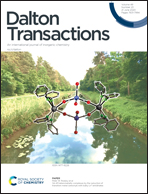Self-assembled octanuclear [Ni5Ln3] (Ln = Dy, Tb and Ho) complexes: synthesis, coordination induced ligand hydrolysis, structure and magnetism†
Abstract
The variable coordination behavior of 2-{[(2-hydroxy-3-methoxybenzyl)imino]methyl}-6-methoxyphenol (H2L) and its hydrolyzed congener towards NiCl2·6H2O and LnIII nitrate salts provides a family of coordination aggregates containing an [Ni5Ln3] octanuclear core structure. Room temperature reactions in MeOH−CHCl3 medium and in the presence of NEt3 yielded isostructural [Ni5Ln3(L)4(μ-OH)2(μ3-OH)6(o-val)2(H2O)6]NO3·7H2O (Ln = Dy3+ (1), Tb3+ (2), and Ho3+ (3); o-val = o-vanillin) heterometallic complexes. All the three complexes hold an octanuclear fused partial hexacubane topology from the utilization of phenolate-based ligand anions, clipping five 3d and three 4f ions. Direct current magnetic susceptibility measurements showed an upsurge at low temperature for complexes 1 and 2, indicative of ferromagnetic interactions, while antiferromagnetic exchange interaction predominates for complex 3. AC magnetic susceptibility measurements were not able to show any slow relaxation property to the magnetization. CASSCF calculations for complex 1 indicate that all three Dy3+ centres have anisotropic axes but the relative orientation of the magnetic axes reduces the probability of this molecule to behave like an SMM which is further established by the POLY_ANISO calculations.
![Graphical abstract: Self-assembled octanuclear [Ni5Ln3] (Ln = Dy, Tb and Ho) complexes: synthesis, coordination induced ligand hydrolysis, structure and magnetism](/en/Image/Get?imageInfo.ImageType=GA&imageInfo.ImageIdentifier.ManuscriptID=D0DT01675F&imageInfo.ImageIdentifier.Year=2020)


 Please wait while we load your content...
Please wait while we load your content...